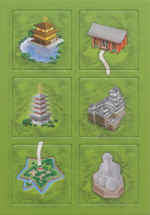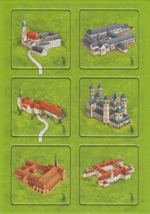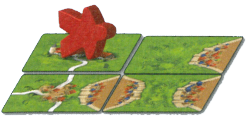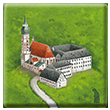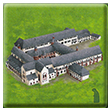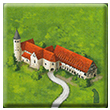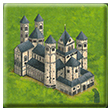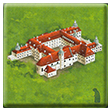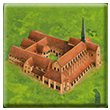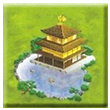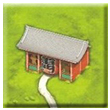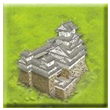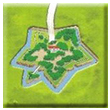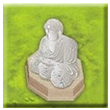Abbayes d’Allemagne et Monuments japonais
Informations générales et commentaires
Abbayes d’Allemagne pour la seconde édition a été dévoilée par Hans im Glück en Template:Year fr pendant l’Essen Spiel.
Cette mini extension ajoute 6 célèbres abbayes allemandes à vos parties de Carcassonne et modifie la manière d'évaluer ce type de tuile. Ce n'est que lors de l'évaluation finale que vous saurez si vous avez pris les bonnes décisions en cours de partie.
Avant cette publication, une autre mini extention Monuments Japonais, avec les mêmes règles, a été éditée par Hans im Glück en Template:Year fr. Elle possède des illustrations de Toshihiko Ishibashi qui ne correspondent pas au style de la première édition, bien que le manuel ait été basé sur cette édition. Néanmoins, elle est considérée comme une mini extension de la nouvelle édition. Ces tuiles n'ont pas de symbole d'extension.
Cette mini extension a été conçue pour le jeu de base de Carcassonne et suit donc les règles normales du jeu. Vous pouvez utiliser "Abbayes d'Allemagne" avec toutes les autres extensions du jeu, mais il n’existe aucune règle officielle pour expliquer les différentes interactions possibles.
Matériel
- Abbayes d’Allemagne : 6 tuiles Terrain représentant de célèbres abbayes allemandes
- Monuments japonais : 6 tuiles Terrain représentant de célèbres monuments du Japon
Rules
Although the Meeple can be used as an abbot in this expansion, this should not be confused with the abbot meeple from The Abbot expansion.
Preparation
Remove the “original” monastery tiles from the base game and return them to the box. [1] Mix the six new monastery tiles in with the rest of the game tiles.
Gameplay
1. Placing a tile
If a player draws one of the special monastery tiles, it is placed according to the normal rules.
2. Placing a meeple
After placing the special monastery tile, the player may place a meeple on any feature present on the tile according to the normal rules. If deploying a meeple on the monastery, the player has two options: [2]
- As a Monk: In this option, the monastery is treated like a monastery in the base game, and all the normal scoring rules remain the same; or
- As an Abbot: In this option, the meeple is considered an abbot of the monastery. To emphasize this, the player stands the meeple on its side to signify that the special monastery will be scored differently than a original monastery. The monastery scores only at the end of the game.
These two options are available whenever a meeple would be placed on the monastery: initial tile placement, wagon movement, magic portal, flier, etc.
Note that the special monastery is only a single feature, even though it can be used two different ways. Thus, if it is occupied by a meeple, one cannot place a phantom there, drive the wagon there, or deploy a meeple to it with a magic portal.
3a. Scoring a monk
A meeple placed on a special monastery as a monk follows the regular scoring rules of Carcassonne.
3b. Final scoring of an abbot
An abbot on a special monastery is not scored until the end of the game. For his abbot, the player receives 1 point per tile present in the vertical column and horizontal row outward from the monastery. The monastery tile itself also scores 1 point. Any empty spaces in the monastery’s row or column interrupt the series of tiles that score for the monastery.
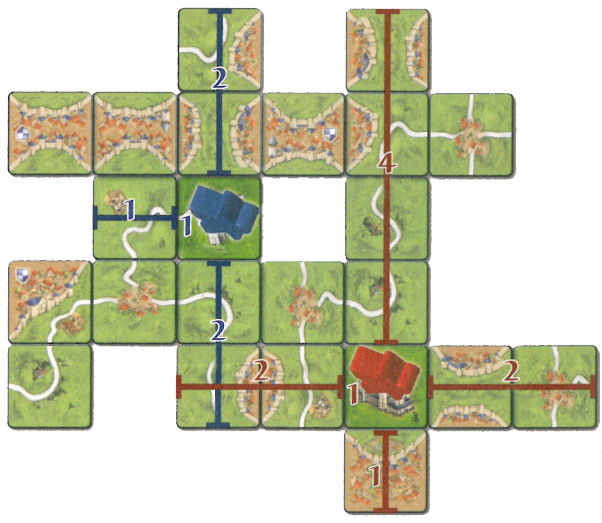
Note: For the sake of clarity, the figures in the additions correspond to the number of tiles in the column above, the row to the right, the column below, the row to the left and the monastery itself respectively.
Interactions with other expansions
General comments
- You can occupy a special monastery with the following figures placing them as a monk (standing) or as an abbot (on its side):
- Normal meeple, the standard option (Base game)
- Abbot meeple (Base game - The Abbot)
- Large meeple (Exp. 1 - Inns and Cathedrals)
- Wagon (Exp. 5 - Abbey & Mayor)
- Ringmaster (Exp. 10 - Under the Big Top)
- Phantom (The Phantom)
- A special monastery accepts two possible meeple placements: as a monk or as an abbot. The normal rules assume that only one of these cases may happen at a time but, in combination with other expansions (see Exp. 6 - Count, King and Robber and The Flier (Flying Machines)), several meeples may be present on a monastery during scoring. This leads to the following scenarios:
- Special monastery occupied by at least one monk (and any number of meeples placed as abbots):
- The feature will be completed when surrounded by tiles.
- The player(s) with the majority of monks will receive points for the completed monastery, and the monks will be returned to their owners.
- Any meeples placed as abbots on the feature are not considered for this scoring and will stay on the feature (see next scenario).
- Special monastery occupied by meeples placed as abbots only:
- The feature will not be completed even if surrounded by tiles.
- The special monastery will be scored at the end of the game, where the player(s) with the majority of meeples placed as abbots will receive the points.
- Special monastery occupied by at least one monk (and any number of meeples placed as abbots):
 Count, King And Robber
Count, King And Robber
An abbot cannot be involved in a challenge with a heretic on a shrine/cult place, as the two scoring mechanisms are entirely different (the abbot's monastery is never completed, so the heretic would always win).
Players may deploy meeples from the cathedral district to a completed monastery about to be scored. The meeples can only be deployed as monks. Deploying meeples as abbots is not allowed since they would not participate in the scoring.
 Bridges, Castles And Bazaars
Bridges, Castles And Bazaars
Because an abbot scores only at the end of the game, and this special monastery is never considered completed, a monastery with an abbot will not score points for a meeple in a castle.
 Hills and Sheep
Hills and Sheep
When using special monasteries, the vineyard bonus is applied to the special monastery if the meeple is placed as a monk and the feature is scored as a finished original monastery. However, the vineyard bonus is not applied if a meeple is placed as an abbot on a special monastery, as the abbot scores only at the end of the game, when the vineyard has no effect.
 The Flying Machines
The Flying Machines
If a second meeple is placed on the special monastery through use of the The Flying Machines, the player can choose to make the new meeple either a monk or an abbot, regardless of the identity of the first meeple there. However, if the special monastery is already surrounded by 8 tiles, thus representing a completed monastery, the second meeple must be an abbot.
Ensemble des tuiles
Abbayes d’Allemagne
Total des tuiles : 6
Monuments japonais
Total des tuiles: 6
Les abbayes en détail
Abbayes d’Allemagne
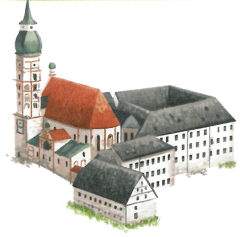 |
Abbaye d'Andechs (Bavière) On the eastern shore of Lake Ammersee, Andechs Monastery, the oldest pilgrimage site in Bavaria, is located. It was founded in 1455 as a branch office of the Benedictine monks. The monastery is also known far beyond the borders of Bavaria for its beer. www.andechs.de |
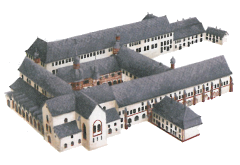 |
Abbaye d'Eberbach (Hesse) The Eberbach Monastery is a former Cistercian abbey near Eltville. The monastery was founded in the 12th century, and with its Romanesque and early Gothic features, is one of the most important monuments in Europe. It gained worldwide fame as a filming location for the film adaptation of the novel "The Name of the Rose" by Umberto Eco. www.kloster-eberbach.de |
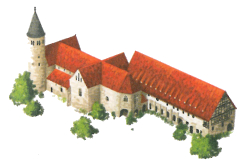 |
Abbaye de Lorch (Bade-Wurtemberg) Lorch, a former Benedictine monastery, is situated on a mountain ridge above the Rems valley, and is visible from far away. It was donated in 1102 by Duke Frederick I of Swabia and his family. The heyday of the Benedictine monastery was during the late Middle Ages. Even today, the charming monastery, complete with church, retreat, farm buildings and a garden, surrounded by a circular wall, is still completely intact, and attracts many visitors. |
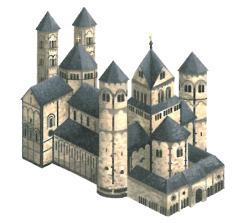 |
Abbaye de Maria Laach (Eifel/Rhénanie-Palatinat) Founded in 1093 the Maria Laach is a high medieval monastery, located on the southwest side of Laacher Lake. A landmark of this Benedictine monastery is the 6-towered monastery church, the Laacher Munster. |
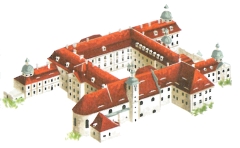 |
Abbaye de Marienthal (Saxe) The monastery of St. Marienthal is the oldest convent of the Cistercian Order in Germany. It has continuously been in operation from its founding in 1234 until today. It is situated near Görlitz, on the border triangle of Germany, Poland and the Czech Republic. www.kloster-marienthal.de |
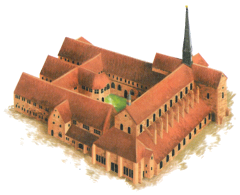 |
Abbaye de Maulbronn (Bade-Wurtemberg) The Maulbronn Monastery, a former Cistercian abbey which is now recognized as a World Heritage Site, is considered to be the most well-preserved medieval monastery north of the Alps. Founded in the 12th century, all styles and levels of development of the Romanesque period through the late Gothic period are represented here. www.kloster-maulbronn.de |
Monuments japonais
 |
Kinkaku-ji (temple du pavillon d’or) This Budhist temple in Kyoto is covered in gold and is one of the most popular buildings in Japan, attracting a large number of visitors anually. It was registered as a Wold Heritage Site in 1994. https://en.wikipedia.org/wiki/Kinkaku-ji |
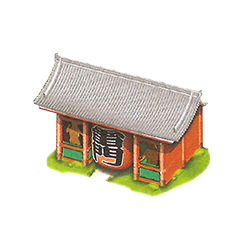 |
Kaminarimon (porte de la foudre) It is the gate of Sensoji in Tokyo. It was first built in 941 by a military commander but then reconstructed at its current location in 1635. It is said that this was the time when they built the 2 statues flanking the gate, though it has been burnt down a couple of times and the current structure dates from 1960. https://en.wikipedia.org/wiki/Kaminarimon |
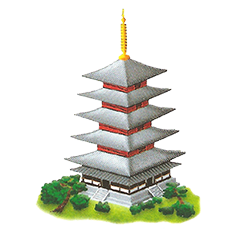 |
Gojyu-no-tō (pagode à cinq étages) It is in HOURYUJI. Hourjuyi is an area with the oldest wooden buildings in the world. Many pictures and carvings show the history of Japan for more than 1.300 years. In 1993, it was Japan first registered World Heritage Site. |
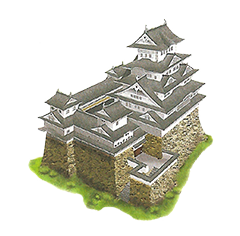 |
Himeji-jō (château de Himeji) It is also called Shirasagijo (Egret castle). This castle comprising 83 buildings with highly developed systems of defence and ingenious protection devices dates from the beginning of the Shogun period. It is a masterpiece of contruction in wood, combining function with aesthetic appeal, and also registered a World Heritage Site in 1993. |
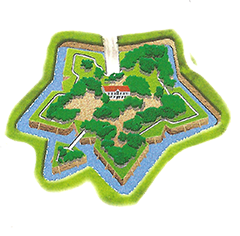 |
Goryōkaku (fortification à cinq côtés) It is a fort in Hokkaido and was built to protect the city of Hokodate. It is a famous place for the fight between the old government (Shogun side) and the new goverment (Imperial side) in the last stage of the Edo period. After the fort had lost its military importance, it was eventually turned into a public park in the 1910s. Over one thousand cherry trees were planted along its moats, making it one of Hokkaido's best cherry blossom spots. https://en.wikipedia.org/wiki/Goryōkaku |
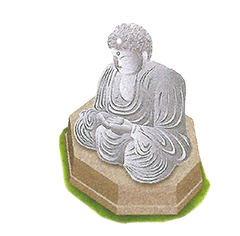 |
Kamakura Daibutsu (grand Bouddha de Kamakura) It is a Buddhist temple mainly containing one giant bronze statue of Buddha with a height of 13.35m and a weight of 121t. Monks may enter it to pray inside the statue. Its first building was made out of wood and dates from 1252. A few years later, as the wooden structure was damaged badly by a storm, it was decided to build it from Bronze. Since the big tsunami in September 20, 1488 washed all buildings away, the statue stays in the open air. https://en.wikipedia.org/wiki/Kōtoku-in |
Notes
Pour les licences et les explications des icônes, veuillez visiter la page des icônes.
- ↑
 As an alternative, the special Monasteries could simply be added to the regular tiles without removing the original monastery tiles. However, if only playing with the base game and no other expansions, this may be too many monastery tiles. (4/2014)
As an alternative, the special Monasteries could simply be added to the regular tiles without removing the original monastery tiles. However, if only playing with the base game and no other expansions, this may be too many monastery tiles. (4/2014)
- ↑
 This paragraph was reworded to indicate that players can also place meeples on other features available on the tile besides the monastery, namely in the field or a road, if available.
This paragraph was reworded to indicate that players can also place meeples on other features available on the tile besides the monastery, namely in the field or a road, if available.
- Editor Manual - Old numbered parameters - RulesPlacingTile
- Editor Manual - Old numbered parameters - RulesPlacingMeeple
- Editor Manual - Old numbered parameters - RulesScoring
- Editor Manual - Old numbered parameters - Tile
- Old template
- Old template - FootnoteIconPara fr
- Under Construction
- Seconde édition
- Extension mineure de la seconde édition
